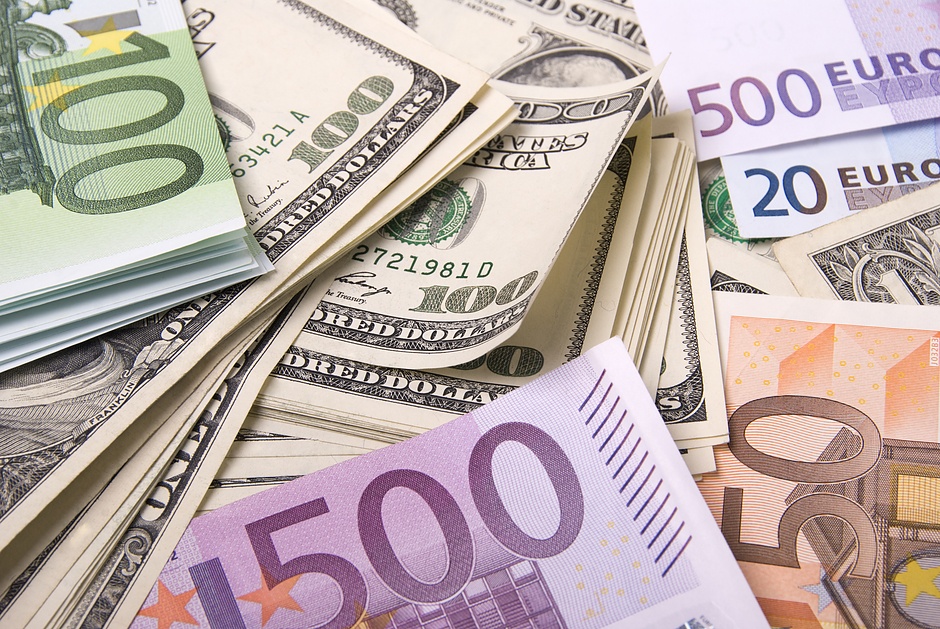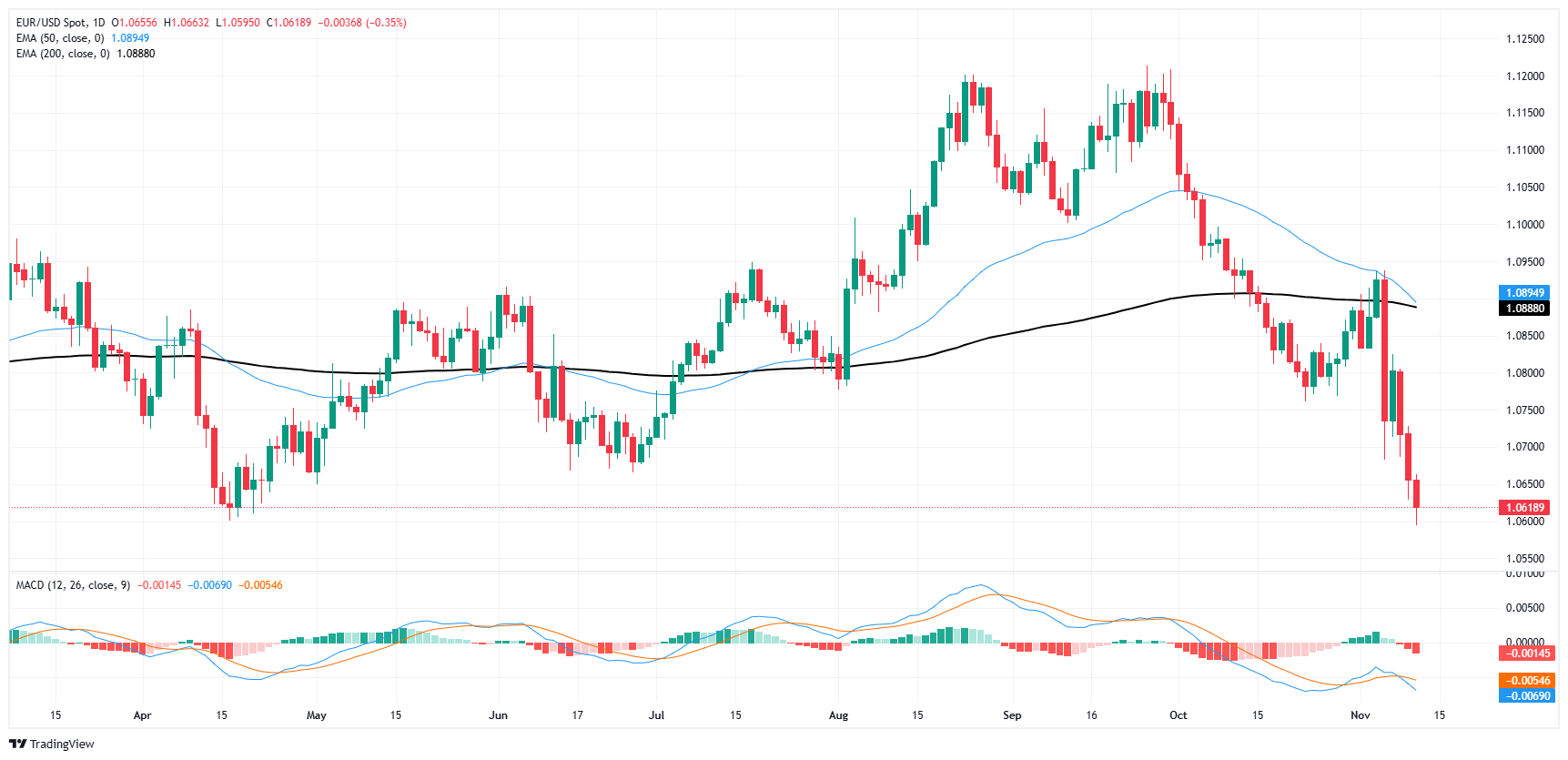Created
: 2024.11.13













![]() 2024.11.13 08:07
2024.11.13 08:07
EUR/USD trimmed further into low the side on Tuesday, shedding another third of a percent. Fiber briefly tested below 1.0600 during the day's market session, and the pair is poised for further losses after a rapid seven-week decline from multi-month highs set just above 1.1200 in September.
A lack of meaningful EU-centric economic data has left Greenback flows front and center of the Fiber chart, though Euro traders will be looking ahead to Thursday's pan-EU Gross Domestic Product (GDP) update. The EU's third quarter GDP is expected to confirm the preliminary print of 0.4% QoQ, and the annualized figure is forecast to show that Europe grew by an unremarkable 0.9% YoY.
US CPI inflation figures for the month of October are slated to release on Wednesday, and markets are expecting a rebound in annualized headline consumer price growth. Full-fat CPI inflation is forecast to tick higher to 2.6% YoY compared to September's print of 2.4%. Core CPI inflation is expected to hold steady at 3.3% YoY. The monthly figure for both inflation categories are broadly expected to hold flat month-on-month.
The EUR/USD daily chart shows a clear bearish trend, with the pair trading well below the 50-day EMA (1.0895) and the 200-day EMA (1.0888). The downward momentum has accelerated after EUR/USD broke below these moving averages, both of which are now acting as resistance levels. The alignment of the shorter-term EMA below the longer-term EMA further signals that the bears are firmly in control, confirming a downtrend in the near term.
Adding to the bearish bias, the MACD indicator is showing strong downward momentum. The MACD line is below the signal line, with both moving deeper into negative territory. The histogram has expanded significantly on the downside, indicating that bearish momentum remains robust. This setup on the MACD suggests that sellers are currently dominant and that buyers have yet to step in with sufficient strength to reverse the downward trend. Without a bullish crossover or a reduction in the histogram's size, the bearish trend is likely to persist.
In terms of support levels, EUR/USD is approaching the psychological level of 1.0600, which could offer some relief to the downside pressure. If this support level fails to hold, the pair may target the 1.0500 level, where further buying interest might emerge. For the bulls to regain control, a break back above the 200-day EMA is essential, but given the current technical structure, such a recovery seems unlikely in the short term. As it stands, the bearish outlook remains intact, with downside risks prevailing in the near term.

The Euro is the currency for the 19 European Union countries that belong to the Eurozone. It is the second most heavily traded currency in the world behind the US Dollar. In 2022, it accounted for 31% of all foreign exchange transactions, with an average daily turnover of over $2.2 trillion a day. EUR/USD is the most heavily traded currency pair in the world, accounting for an estimated 30% off all transactions, followed by EUR/JPY (4%), EUR/GBP (3%) and EUR/AUD (2%).
The European Central Bank (ECB) in Frankfurt, Germany, is the reserve bank for the Eurozone. The ECB sets interest rates and manages monetary policy. The ECB's primary mandate is to maintain price stability, which means either controlling inflation or stimulating growth. Its primary tool is the raising or lowering of interest rates. Relatively high interest rates - or the expectation of higher rates - will usually benefit the Euro and vice versa. The ECB Governing Council makes monetary policy decisions at meetings held eight times a year. Decisions are made by heads of the Eurozone national banks and six permanent members, including the President of the ECB, Christine Lagarde.
Eurozone inflation data, measured by the Harmonized Index of Consumer Prices (HICP), is an important econometric for the Euro. If inflation rises more than expected, especially if above the ECB's 2% target, it obliges the ECB to raise interest rates to bring it back under control. Relatively high interest rates compared to its counterparts will usually benefit the Euro, as it makes the region more attractive as a place for global investors to park their money.
Data releases gauge the health of the economy and can impact on the Euro. Indicators such as GDP, Manufacturing and Services PMIs, employment, and consumer sentiment surveys can all influence the direction of the single currency. A strong economy is good for the Euro. Not only does it attract more foreign investment but it may encourage the ECB to put up interest rates, which will directly strengthen the Euro. Otherwise, if economic data is weak, the Euro is likely to fall. Economic data for the four largest economies in the euro area (Germany, France, Italy and Spain) are especially significant, as they account for 75% of the Eurozone's economy.
Another significant data release for the Euro is the Trade Balance. This indicator measures the difference between what a country earns from its exports and what it spends on imports over a given period. If a country produces highly sought after exports then its currency will gain in value purely from the extra demand created from foreign buyers seeking to purchase these goods. Therefore, a positive net Trade Balance strengthens a currency and vice versa for a negative balance.
![]()
Created
: 2024.11.13
![]()
Last updated
: 2024.11.13

FXStreet is a forex information website, delivering market analysis and news articles 24/7.
It features a number of articles contributed by well-known analysts, in addition to the ones by its editorial team.
Founded in 2000 by Francesc Riverola, a Spanish economist, it has grown to become a world-renowned information website.
We hope you find this article useful. Any comments or suggestions will be greatly appreciated.
We are also looking for writers with extensive experience in forex and crypto to join us.
please contact us at [email protected].
Disclaimer:
All information and content provided on this website is provided for informational purposes only and is not intended to solicit any investment. Although all efforts are made in order to ensure that the information is correct, no guarantee is provided for the accuracy of any content on this website. Any decision made shall be the responsibility of the investor and Myforex does not take any responsibility whatsoever regarding the use of any information provided herein.
The content provided on this website belongs to Myforex and, where stated, the relevant licensors. All rights are reserved by Myforex and the relevant licensors, and no content of this website, whether in full or in part, shall be copied or displayed elsewhere without the explicit written permission of the relevant copyright holder. If you wish to use any part of the content provided on this website, please ensure that you contact Myforex.
Myforex uses cookies to improve the convenience and functionality of this website. This website may include cookies not only by us but also by third parties (advertisers, log analysts, etc.) for the purpose of tracking the activities of users. Cookie policy